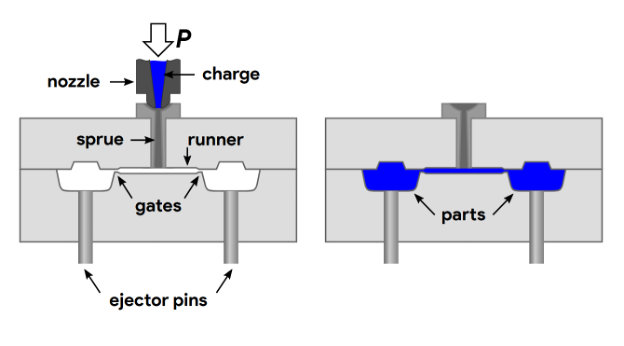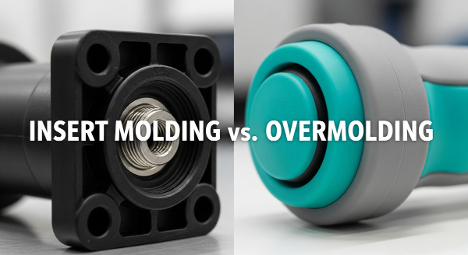Molding is a manufacturing process that is widely used to create a variety of products across different industries. Molding parts are used in various applications such as automotive, aerospace, medical, electronics, consumer goods, and more. The process involves shaping the material into a specific form using a mold and then treating that mold as per the requirements of the process. There are usually two molding methods available, including custom injection molding and thermoforming.

What Are Injection Molding and Thermoforming?
Custom injection molding is a popular molding method used to create high-quality and complex parts. It involves melting a plastic material and injecting it into a mold cavity under high pressure. The melted material is then cooled and solidified, creating a final product with accurate dimensions and a smooth surface finish.
Thermoforming, on the other hand, is a molding method used to create parts by heating and shaping plastic sheets. The process involves heating a flat sheet of plastic until it is pliable and then placing it onto a mold. The sheet is then vacuumed onto the mold, conforming to its shape, and cooled to create the final part.
Injection Molding Vs. Thermoforming: Head-to-Head Comparison
Injection molding and thermoforming differ in the following ways:
Production Scale
Thermoforming is used for smaller production quantities. But plastic injection molding is typically used for more intricately designed parts in small sizes with higher-volume production runs. Larger injection molded parts are generally limited to specific industries such as automotive and consumer electronics.
Part Size
Thermoforming is used to make large parts where the details can be compromised. But injection molding is used for manufacturing small designs by giving too much importance to details.
Tolerance
Custom injection molding manufactures products with tight tolerances and intricate designs, while thermoforming parts are manufactured with high tolerances and simple designs.
Cost
The tools used in custom injection molding are also relatively more expensive than the tools used in thermoforming. Due to these expensive tools and the manufacturing of intricate designs, injection molding is a bit more expensive than thermoforming.
Once you have the required tools, thermoforming production can be completed within 1-2 weeks. However, custom injection molding often takes 4-5 weeks of time since more complicated and accurate products are made using this method.
Available Material
In thermoforming, thermoplastic, Poly (methyl methacrylate), and polycarbonate are used.
On the other hand, thermoplastic pellets with varied materials and colors, plastic, Poly(methyl methacrylate), polycarbonate, Polyvinyl chloride, Glass-filled polymers, and flash are used in custom injection molding.
Waste
Plastic injection molding provides low waste compared to thermoforming.

Applications of Custom Injection Molding and Thermoforming
Both custom injection molding and thermoforming have their own pros and cons. Their application scope also differs a bit, so industries mostly opt for the process which suits their needs. Let's see the application of both of these methods.
Injection Molding is used for the following:
- Automotive parts such as dashboards, interior trim, and engine components
- Medical devices such as syringes, inhalers, and catheters
- Electronic components like phone cases, computer keyboards, and TV remote controls
- Packaging materials, including bottle caps, food containers, and lids
- Household items such as toys, kitchenware, and furniture components
- Aerospace parts, primarily interior panels, and structural components
Thermoforming is used for:
- Food packaging: tray, container, and cup
- Medical packaging: blister, clamshell, and tray
- Automotive parts like interior panels and trim
- Signs and displays such as advertising signs and point-of-purchase displays
- Sports equipment such as helmets, pads, and guards
- Building and construction products like shower stalls, wall panels, and light fixtures
Conclusion
HordRT brings innovative ways of doing custom injection molding, which will help you manufacture top-notch products in cost-effective ways. One of the major benefits of availing of our plastic injection molding service is that we have a wide variety of materials available, including ABS, TPU, HDPE, PCTG, PC, PA66, Nylon, and PPE, among others. Not only this, but we also provide high-quality surface finishing, which allows you to improve the smoothness of your products. As we provide instant quoting about your order with no minimum Order Quantity conditions in a cost-effective manner, getting our services availed is the best bet for industries looking for custom injection molding.
Established in 2013, HordRT is now dominating the global market as our researchers and engineers have brought us a long way. We are specialized in plastic injection molding, rapid tooling making, pressure die casting, rapid CNC manufacturing, and many other such processes. We are certified by global watchdogs, which means that they don’t believe in compromising quality.
-q4gvl4k29y4hq8j9rjpapvj0ft06fje63olt7p210i.png)


